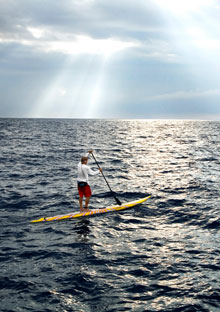
Hamilton, surfing for the
Beautiful Son Foundation
Beautiful Son Foundation
For surfers, philanthropy is genetic.
At 2 a.m. on a summer morning somewhere off the coast of San Clemente, California, professional surfer
Laird Hamilton slices through the folds of the Pacific Ocean. He's on the final leg of a 110-mile stand-up
paddle, ten miles out to sea, with no shoreline in sight. Aside from the glint of moonlight, visibility is low,
but Hamilton, who routinely rides waves more than 80 feet high, thrives in situations like this. His all-night
paddle, in fact, is merely a race to the starting line. Tomorrow he'll embark on a cycling competition from
San Diego to Annapolis, Maryland, known as the Race Across America, and as signs of sleep deprivation and
delirium have already begun to surface from 18 hours of paddling, one can't help asking, "Why?"For charity.
"It gives us a purpose beyond our own personal achievement," says Hamilton, whose journey raised money for cystic fibrosis, Lou Gehrig's disease, and autism—conditions that have affected people close to him. "It's really about the causes; we've found that gives a drive and a motivation we might not have otherwise."
While Hamilton's commitment to philanthropy is impressive, it's increasingly common among his surfing colleagues. Surprisingly, the sun-streaked, stuttering-Spicoli counterculture widely regarded as apathetic to anything other than the latest wave report now includes some of the planet's more socially aware athletes. "I think there's something there genetically with us—somehow engineered into the way we live our lives," says nine-time world champion Kelly Slater, who started the Kelly Slater Foundation in 2007, and cofounded Surfing for Peace, which promotes constructive dialogue in the Middle East. (Slater also lends time and money to causes like Surfers Healing, which has taught more than 3,000 autistic kids to surf.) "Although we want to have waves to ourselves, I think we have a worldwide sense of community, and we tend to try to keep it that way when something comes along we can help with."
"Honestly, it's a no-brainer," says three-time U.S. Open of Surfing champion Rob Machado of surfers' propensity to give. As founder of the Rob Machado Foundation, he encourages ocean awareness in San Diego schools. "If you can reach out to kids and show them the right way, I think that's going to spread for years."
But it's not just the stars of the sport supporting causes from the humanitarian to the environmental. Jesse Billauer, a surfer who became paralyzed 13 years ago after crashing headfirst into a sandbar, founded the Life Rolls On Foundation to help others affected by spinal cord injuries. Operation Amped has introduced surfing's restorative powers to the military community, teaching wounded war veterans to ride waves. Likewise, the grassroots organization SurfAid International was among the first responders to go in after the 2004 Indonesian tsunami and help rebuild, and the apparel company Volcom recently initiated a campaign to donate thousands of surf trunks to local charities. Surfers for Cetaceans, an organization cofounded by Australian surfer Dave Rastovich, has drawn worldwide attention to the commercial massacre of dolphins in Japan; his fearless investigation of the underwater slaughterhouse dubbed "the Killing Cove" inspired the 2009 documentary The Cove .
Maybe a larger sense of commitment and perspective is simply endemic to a sport that involves a thrilling proximity to nature, in all its soul-stirring limitlessness. "The surfing horizon is not bounded by a white line or fairway," says the 1977 World Champion and Surfrider board member Shaun Tomson. "It spans as far as the eye can see, and in that idea of our playing field as the horizon—which connects all of us— we have a different philosophical view of how our sport or lifestyle or art form fits into the world. I think it's a fundamental law of surfing that we all must give back."
More Stories of Giving
Zach Weisberg is online editor for Surfer Magazine.
Photo: Don King







